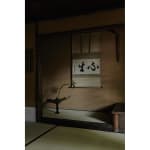Bankei Yōtaku (1622–1693)
Fushō (unborn)
Ink on paper, hanging scroll
With box authentication by Kawashima Shoin
Seals: Rinzai Shoshu; Bankei; Yotaku
32.5 x 62.5 cm
119 x 65 cm (overall)
With box authentication by Kawashima Shoin
Seals: Rinzai Shoshu; Bankei; Yotaku
32.5 x 62.5 cm
119 x 65 cm (overall)
Further images
The Zen master Bankei Yotaku was born as the son of a physician in Aboshi Hamada (now Himeji City) in Harima Province. At a young age, he questioned his teacher on the first line from the Confucian classic Great Learning, “the way of great learning clarifies bright virtue,” and left unsatisfied with the answer. At seventeen, he became a Buddhist monk under Unpo Zensho of Zuio-ji temple in Ako and began practicing Zen meditation. He spent his days undergoing austere training without reaching any conclusion and became gravely ill. In this way, Bankei spent many years in anguish until he experienced an awakening in the spring of his thirty-first year. Thereafter, he traveled throughout Japan until he became the 218th abbot of Myoshin-ji temple in Kyoto by imperial decree and received a purple robe at the age of fifty-one in 1672.
The concept, “unborn,” signifies the foundation of Bankei’s Zen thought. That which is unborn or does not arise is never extinguished, thus to be unborn means to be undying and thereby transcending existence itself. Everyone is born from their parents and has the unborn Buddha mind, or formless Buddha. This Bankei’s teaching reverberated in people’s hearts at the time.
Bankei’s calligraphy is unusual for a Zen monk as it strongly reflects the o-ie ryu, or “courtier style,” which was developed by the Cloistered Prince Shoren-in Son’en (d. 1356). This calligraphic mode was the basic style of private secretaries for both the courtier and warrior classes until the Edo period and became practiced widely among commoners through terakoya, or private elementary schools. It is said that this style of calligraphy supported the high literacy rate in the early modern Japan. Bankei’s calligraphy, which followed this tendency, in spite of depending on the historic background from which he was born and raised, likely reflects his desire to widely spread his teachings. The two distinct and bold characters here embody the essence of Bankei’s Zen.
Bankei Yotaku (Zen priest; 1622−1693)
Also known as Daihoshogen-kokushi (posthumous).
Harima-born early Edo-period Rinzai School Zen priest. The 218th chief abbot of Myoshin-ji temple. The third son of the Confucian doctor Sugawara Dosetsu. Became a disciple of Unpo at Zuio-ji temple in Ako, established Ryomon-ji temple in his hometown Hamada, and later became the chief abbot of Myoshin-ji temple in Kyoto.
The concept, “unborn,” signifies the foundation of Bankei’s Zen thought. That which is unborn or does not arise is never extinguished, thus to be unborn means to be undying and thereby transcending existence itself. Everyone is born from their parents and has the unborn Buddha mind, or formless Buddha. This Bankei’s teaching reverberated in people’s hearts at the time.
Bankei’s calligraphy is unusual for a Zen monk as it strongly reflects the o-ie ryu, or “courtier style,” which was developed by the Cloistered Prince Shoren-in Son’en (d. 1356). This calligraphic mode was the basic style of private secretaries for both the courtier and warrior classes until the Edo period and became practiced widely among commoners through terakoya, or private elementary schools. It is said that this style of calligraphy supported the high literacy rate in the early modern Japan. Bankei’s calligraphy, which followed this tendency, in spite of depending on the historic background from which he was born and raised, likely reflects his desire to widely spread his teachings. The two distinct and bold characters here embody the essence of Bankei’s Zen.
Bankei Yotaku (Zen priest; 1622−1693)
Also known as Daihoshogen-kokushi (posthumous).
Harima-born early Edo-period Rinzai School Zen priest. The 218th chief abbot of Myoshin-ji temple. The third son of the Confucian doctor Sugawara Dosetsu. Became a disciple of Unpo at Zuio-ji temple in Ako, established Ryomon-ji temple in his hometown Hamada, and later became the chief abbot of Myoshin-ji temple in Kyoto.











